Leather Set WWI History WORLD WAR ONE! First 1st Library America Antique Great



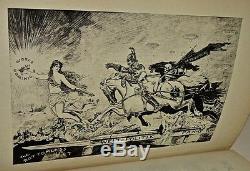
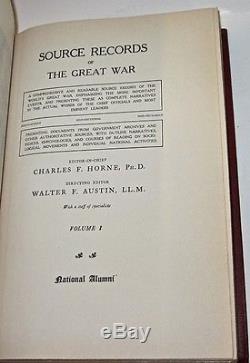
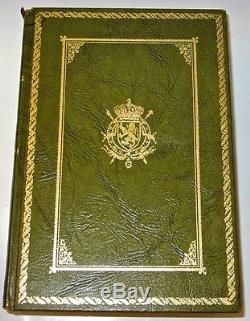
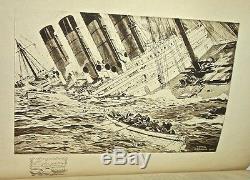
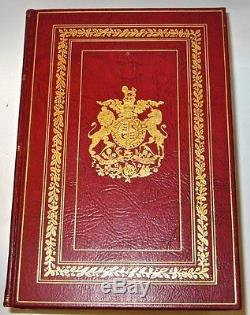
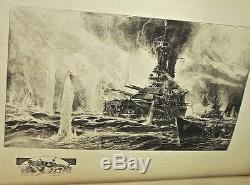
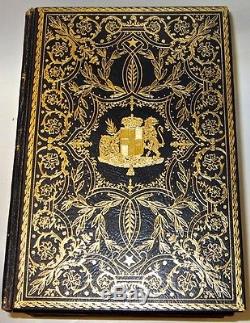
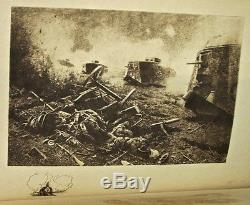


Also, please my other listings for similar sets. History of World War One. Source Records Of The Great War. A comprehensive and readable source record of the world's great war, emphasizing the more important events, and presenting these as complete narratives in the actual words of the chief officials and most eminent leaders : non-partisan, non-sectional, non-sectarian : presenting documents from government archives and other authoritative sources, with outline narratives, indices, chronologies, and courses of reading on sociological movements and individual national activities.
Complete in 7 volumes, as issued. This is the standard number for this set. These are the original red, blue and green leather bindings, styled after the treaty of Versailles bindings.
The leather edition of this volume is beautifully crafted. Each volume is an authorized facsimile of a different county's copy of the Versailles Peace Treaty. Ornate gilded spine and covers. These are very large books measuring 9 1/2 inches tall!VERY GOOD condition overall but for the chip to volume 7, some general shelf wear. All hinges fully attached, but with some surface cracking on some hinges not affecting their integrity, all held strongly by the underlying binding materials. The leather is thin, as issued, and appears designed for appearance more so than structure. All interiors are clean, free of foxing.
No writing or signs of previous ownership. Thin composite leather is low grade but as issued. Source records of the great war: a comprehensive and readable source record of the world's great war, emphasizing the more important events, and presenting these as complete narratives in the actual words of the chief officials and most eminent leaders : non-partisan, non-sectional, non-sectarian : presenting documents from government archives and other authoritative sources, with outline narratives, indices, chronologies, and courses of reading on sociological movements and individual national activities.
I - "the original art binding of the official French copy of the Versailles Peace Treaty which was signed by President Poncaré and Pichon". I signed by registrar to certify this registered edition. This unique complete set is a fantastic tribute to history. A great addition to any collection. This set was originally issued in leather or cloth bindings.
This set is bound in the more desirable, genuine albeit composite leather. This would make an excellent gift and/or addition to any fine library. Antiquarian books make a great investment, are only going up in value, and are sure to increase the aura of any room or office!
Prices have been dramatically lowered for he holidays. Please consider this item completely AS-IS! Please consider this as is.
Customer service is important to me. Please communicate any questions or concerns. Please keep this in mind.This set weighs well over 40lbs. Accepting the risk of any loss, damage, and or delay.
Everything is listed completely as-is. Please communicate with me any concerns.
Charles Francis Horne born January 12, 1870 in Jersey City. Died September 13, 1942 in Annapolis. He wrote or edited more than one hundred books, mostly multi-volume history works.He was a Professor of English. At City College of New York.
"World War One", "Great War", "WW1", "First World War", and "WWI" redirect here. For the album by White Whale, see WW1 (album). For other uses, see World War One (disambiguation). Clockwise from the top : The aftermath of shelling during the Battle of the Somme. Sinks after hitting a mine. A British Vickers machine gun. During the Battle of the Somme, Albatros D.28 July 1914 11 November 1918 (4 years, 3 months and 2 weeks). Signed 28 June 1919 (4 years and 11 months).
Signed 10 September 1919 (5 years, 1 month, 1 week and 6 days). Signed 27 November 1919 (4 years, 1 month, 1 week and 6 days).Signed 4 June 1920 (5 years, 10 months and 1 week). Signed 10 August 1920 (6 years, 1 week and 6 days).
Signed 24 August 1921 (3 years, 8 months, 2 weeks and 3 days). Signed 25 August 1921 (4 years, 4 months, 2 weeks and 5 days). Signed 29 August 1921 (3 years, 8 months, 3 weeks and 1 day). Signed 24 July 1923 (8 years, 8 months, 3 weeks and 4 days).
Europe, Africa, the Middle East, the Pacific Islands. China, Indian Ocean, and off the coast of South and North America. Formation of new countries in Europe and the Middle East. And regions of the former Ottoman Empire. Establishment of the League of Nations.
Military dead: 5,525,000 Military wounded: 12,831,500 Military missing: 4,121,000 Total: 22,477,500 KIA, WIA or MIA... Military dead: 4,386,000 Military wounded: 8,388,000 Military missing: 3,629,000 Total: 16,403,000 KIA, WIA or MIA... World War I (WWI or WW1), also known as the First World War , or the Great War , was a global war. Originating in Europe that lasted from 28 July 1914 to 11 November 1918. More than 70 million military personnel.
Including 60 million Europeans, were mobilised in one of the largest wars in history. Died as a result of the war. Including the victims of a number of genocides. , a casualty rate exacerbated by the belligerents' technological and industrial sophistication. And the tactical stalemate caused by gruelling trench warfare.
It was one of the deadliest conflicts in history. And paved the way for major political changes, including revolutions in many of the nations involved.
The war drew in all the world's economic great powers. Assembled in two opposing alliances: the Allies. Based on the Triple Entente. And the United Kingdom of Great Britain and Ireland.
Was a member of the Triple Alliance. Alongside Germany and Austria-Hungary, it did not join the Central Powers, as Austria-Hungary had taken the offensive, against the terms of the alliance.
These alliances were reorganised and expanded as more nations entered the war: Italy, Japan. Joined the Allies, while the Ottoman Empire. The trigger for the war was the assassination of Archduke Franz Ferdinand of Austria.Heir to the throne of Austria-Hungary, by Yugoslav nationalist. This set off a diplomatic crisis. When Austria-Hungary delivered an ultimatum to the Kingdom of Serbia. And entangled international alliances formed over the previous decades were invoked.
Within weeks, the major powers were at war and the conflict soon spread around the world. On 28 July, the Austro-Hungarians declared war on Serbia. As Russia mobilised in support of Serbia, Germany invaded neutral Belgium. Before moving towards France, leading the United Kingdom to declare war on Germany. After the German march on Paris was halted, what became known as the Western Front.
Settled into a battle of attrition. That changed little until 1917. The Russian army was successful against the Austro-Hungarians, but the Germans stopped its invasion of East Prussia. In November 1914, the Ottoman Empire joined the Central Powers, opening fronts in the Caucasus. In 1915, Italy joined the Allies and Bulgaria joined the Central Powers; Romania. Joined the Allies in 1916, as did the United States in 1917. The Russian government collapsed in March 1917.And a revolution in November. Followed by a further military defeat brought the Russians to terms with the Central Powers via the Treaty of Brest Litovsk. Which granted the Germans a significant victory. After a stunning German offensive.
Along the Western Front in the spring of 1918, the Allies rallied and drove back the Germans in a series of successful offensives. The Austro-Hungarian empire agreed to an armistice, and Germany, which had its own trouble with revolutionaries. Agreed to an armistice on 11 November 1918, ending the war in victory for the Allies. By the end of the war or soon after, the German Empire, Russian Empire, Austro-Hungarian Empire.
And the Ottoman Empire ceased to exist. National borders were redrawn, with several independent nations restored or created, and Germany's colonies. Were parceled out among the winners. During the Paris Peace Conference of 1919.(Britain, France, the United States and Italy) imposed their terms in a series of treaties. Was formed with the aim of preventing any repetition of such a conflict. This effort failed, and economic depression, renewed nationalism, weakened successor states, and feelings of humiliation (particularly in Germany) eventually contributed to World War II.
From the time of its start until the approach of World War II. The First World War was called simply the World War or the Great War and thereafter the First World War or World War I. At the time, it was also sometimes called the war to end war. " or "the war to end all wars due to its then-unparalleled scale and devastation. Magazine in October 1914 wrote, Some wars name themselves. This is the Great War. (19181939), the war was most often called the World War and the Great War in English-speaking countries. The term "First World War" was first used in September 1914 by the German biologist and philosopher Ernst Haeckel. Who claimed that there is no doubt that the course and character of the feared'European War'... Will become the first world war in the full sense of the word. Citing a wire service report in The Indianapolis Star on 20 September 1914. After the onset of the Second World War in 1939, the terms World War I or the First World War became standard, with British and Canadian historians favouring the First World War , and Americans World War I. Main article: Causes of World War I. Military alliances leading to World War I; Triple Entente. During the 19th century, the major European powers went to great lengths to maintain a balance of power. Throughout Europe, resulting in the existence of a complex network of political and military alliances throughout the continent by 1900. These began in 1815, with the Holy Alliance. In 1871, Prussia became part of the new German nation. Soon after, in October 1873, German Chancellor Otto von Bismarck. Negotiated the League of the Three Emperors.(German: Dreikaiserbund) between the monarchs of Austria-Hungary, Russia and Germany. This agreement failed because Austria-Hungary and Russia could not agree over Balkan policy, leaving Germany and Austria-Hungary in an alliance formed in 1879, called the Dual Alliance. This was seen as a method of countering Russian influence in the Balkans.
This alliance expanded, in 1882, to include Italy in what became the Triple Alliance. Bismarck had especially worked to hold Russia at Germany's side in an effort to avoid a two-front war with France and Russia. Ascended to the throne as German Emperor. (Kaiser), Bismarck was compelled to retire and his system of alliances was gradually de-emphasised. For example, the Kaiser refused, in 1890, to renew the Reinsurance Treaty. Two years later, the Franco-Russian Alliance. Was signed to counteract the force of the Triple Alliance. In 1904, Britain signed a series of agreements with France, the Entente Cordiale.And in 1907, Britain and Russia signed the Anglo-Russian Convention. While these agreements did not formally ally Britain with France or Russia, they made British entry into any future conflict involving France or Russia a possibility, and the system of interlocking bilateral agreements became known as the Triple Entente. German industrial and economic power had grown greatly after unification and the foundation of the Empire. In 1871 following the Franco-Prussian War. From the mid-1890s on, the government of Wilhelm II used this base to devote significant economic resources for building up the Kaiserliche Marine Imperial German Navy.
, established by Admiral Alfred von Tirpitz. In rivalry with the British Royal Navy. As a result, each nation strove to out-build the other in capital ships. With the launch of HMS Dreadnought. In 1906, the British Empire expanded on its significant advantage over its German rival.
The arms race between Britain and Germany eventually extended to the rest of Europe, with all the major powers devoting their industrial base to producing the equipment and weapons necessary for a pan-European conflict. Between 1908 and 1913, the military spending of the European powers increased by 50%. Sarajevo citizens reading a poster with the proclamation of the Austrian annexation in 1908. Austria-Hungary precipitated the Bosnian crisis.
Of 19081909 by officially annexing the former Ottoman territory of Bosnia and Herzegovina, which it had occupied since 1878. This angered the Kingdom of Serbia. And its patron, the Pan-Slavic. Russian political manoeuvring in the region destabilised peace accords, which were already fracturing in the Balkans which came to be known as the powder keg of Europe.
In 1912 and 1913, the First Balkan War. Was fought between the Balkan League.
And the fracturing Ottoman Empire. The resulting Treaty of London. Further shrank the Ottoman Empire, creating an independent Albanian state while enlarging the territorial holdings of Bulgaria, Serbia, Montenegro, and Greece. When Bulgaria attacked Serbia and Greece on 16 June 1913, it lost most of Macedonia. To Serbia and Greece and Southern Dobruja. To Romania in the 33-day Second Balkan War. Were able to keep these Balkan conflicts contained, but the next one would spread throughout Europe, and beyond.This picture is usually associated with the arrest of Gavrilo Princip. Believe it depicts Ferdinand Behr, a bystander. Main article: Assassination of Archduke Franz Ferdinand.
On 28 June 1914, Austrian Archduke Franz Ferdinand. A group of six assassins Cvjetko Popovi.
From the nationalist group Mlada Bosna. Supplied by the Black Hand. Had gathered on the street where the Archduke's motorcade would pass, with the intention of assassinating the Archduke.At the car, but missed. Some nearby were injured by the blast, but Franz Ferdinand's convoy carried on. The other assassins failed to act as the cars drove past them. About an hour later, when Franz Ferdinand was returning from a visit at the Sarajevo Hospital with those wounded in the assassination attempt, the convoy took a wrong turn into a street where, by coincidence, Princip stood. With a pistol, Princip shot and killed Franz Ferdinand and his wife Sophie.
The reaction among the people in Austria was mild, almost indifferent. Later wrote, the event almost failed to make any impression whatsoever. On Sunday and Monday (28 and 29 June), the crowds in Vienna listened to music and drank wine, as if nothing had happened. Crowds on the streets in the aftermath of the anti-Serb riots in Sarajevo.
The Austro-Hungarian authorities encouraged the anti-Serb riots in Sarajevo. Killed two ethnic Serbs and damaged numerous Serb-owned buildings. Violent actions against ethnic Serbs were also organized outside Sarajevo, in large Austro-Hungarian cities in modern-day Bosnia and Herzegovina, Croatia and Slovenia. Austro-Hungarian authorities in Bosnia and Herzegovina imprisoned and extradited approximately 5,500 prominent Serbs, 700 to 2,200 of whom died in prison. A further 460 Serbs were sentenced to death and a predominantly Bosniak special militia known as the Schutzkorps.
Was established and carried out the persecution of Serbs. The assassination led to a month of diplomatic manoeuvring between Austria-Hungary, Germany, Russia, France, and Britain called the July Crisis. Believing correctly that Serbian officials (especially the officers of the Black Hand) were involved in the plot to murder the Archduke, and wanting to finally end Serbian interference in Bosnia. Austria-Hungary delivered to Serbia on 23 July the July Ultimatum.
A series of ten demands that were made intentionally unacceptable, in an effort to provoke a war with Serbia. The next day, after the Council of Ministers of Russia. Was held under the chairmanship of the Tsar at Krasnoe Selo, Russia ordered general mobilization for Odessa, Kiev, Kazan and Moscow military districts and fleets of the Baltic and the Black Sea.They also asked for other regions to accelerate preparations for general mobilization. Serbia decreed general mobilization on the 25th and that night, declared that they accepted all the terms of the ultimatum, except article six, which demanded that Austrian delegates be allowed in Serbia for the purpose of participation in the investigation into the assassination. Following this, Austria broke off diplomatic relations with Serbia, and the next day ordered a partial mobilization. Finally, on 28 July 1914, Austria-Hungary declared war on Serbia. On 29 July, Russia, in support of its Serb protégé, unilaterally declared outside of the conciliation procedure provided by the Franco-Russian military agreements partial mobilization against Austria-Hungary.
German Chancellor Bethmann-Hollweg was then allowed until the 31st for an appropriate response. On the 30th, Russia ordered general mobilization against Germany. In response, the following day, Germany declared a state of danger of war.
This also led to the general mobilization in Austria-Hungary on 4 August. Kaiser Wilhelm II asked his cousin, Tsar Nicolas II, to suspend the Russian general mobilization.
When he refused, Germany issued an ultimatum demanding the arrest of its mobilization and commitment not to support Serbia. Another was sent to France, asking her not to support Russia if it were to come to the defence of Serbia.
On 1 August, after the Russian response, Germany mobilized and declared war on Russia. The German government issued demands to France that it remain neutral as they had to decide which deployment plan to implement, it being difficult if not impossible to change the deployment whilst it was underway. The modified German Schlieffen Plan.
Aufmarsch II West , would deploy 80% of the army in the west, and Aufmarsch I Ost and Aufmarsch II Ost would deploy 60% in the west and 40% in the east as this was the maximum that the East Prussian railway infrastructure could carry. The French did not respond but sent a mixed message by ordering their troops to withdraw 10 km (6 mi) from the border to avoid any incidents, but at the same time ordered the mobilisation of her reserves. Germany responded by mobilising its own reserves and implementing Aufmarsch II West. Germany attacked Luxembourg on 2 August and on 3 August declared war on France. On 4 August, after Belgium refused to permit German troops to cross its borders into France, Germany declared war on Belgium as well.
Confusion among the Central Powers. The strategy of the Central Powers suffered from miscommunication. Germany had promised to support Austria-Hungary's invasion of Serbia, but interpretations of what this meant differed. Previously tested deployment plans had been replaced early in 1914, but those had never been tested in exercises.Austro-Hungarian leaders believed Germany would cover its northern flank against Russia. Germany, however, envisioned Austria-Hungary directing most of its troops against Russia, while Germany dealt with France. This confusion forced the Austro-Hungarian Army. To divide its forces between the Russian and Serbian fronts.
Main article: Serbian Campaign (World War I). Austria invaded and fought the Serbian army at the Battle of Cer. Over the next two weeks, Austrian attacks were thrown back with heavy losses, which marked the first major Allied victories of the war and dashed Austro-Hungarian hopes of a swift victory.As a result, Austria had to keep sizable forces on the Serbian front, weakening its efforts against Russia. Serbia's defeat of the Austro-Hungarian invasion of 1914 counts among the major upset victories of the twentieth century. German forces in Belgium and France. Main article: Western Front (World War I). British hospital at the Western Front.
At the outbreak of World War I, 80% of the German army was deployed as seven field armies. In the west according to the plan Aufmarsch II West. However, they were then assigned to execute the retired deployment plan Aufmarsch I West , also known as the Schlieffen Plan. This would march German armies through northern Belgium and into France, in an attempt to encircle the French army and then breach the'second defensive area' of the fortresses of Verdun.
And Paris and the Marne river. Aufmarsch I West was one of four deployment plans available to the German General Staff in 1914. Each plan favoured certain operations, but did not specify exactly how those operations were to be carried out, leaving the commanding officers to carry those out at their own initiative and with minimal oversight. Aufmarsch I West , designed for a one-front war with France, had been retired once it became clear it was irrelevant to the wars Germany could expect to face; both Russia and Britain were expected to help France, and there was no possibility of Italian nor Austro-Hungarian troops being available for operations against France. But despite its unsuitability, and the availability of more sensible and decisive options, it retained a certain allure due to its offensive nature and the pessimism of pre-war thinking, which expected offensive operations to be short-lived, costly in casualties, and unlikely to be decisive.
Accordingly, the Aufmarsch II West deployment was changed for the offensive of 1914, despite its unrealistic goals and the insufficient forces Germany had available for decisive success. Moltke took Schlieffen's plan and modified the deployment of forces on the western front by reducing the right wing, the one to advance through Belgium, from 85% to 70%. In the end, the Schlieffen plan was so radically modified by Moltke, that it could be more properly called the Moltke Plan.
The plan called for the right flank of the German advance to bypass the French armies concentrated on the Franco-German border, defeat the French forces closer to Luxembourg and Belgium and move south to Paris. Initially the Germans were successful, particularly in the Battle of the Frontiers.
By 12 September, the French, with assistance from the British Expeditionary Force. (BEF), halted the German advance east of Paris at the First Battle of the Marne.
(512 September) and pushed the German forces back some 50 km (31 mi). The French offensive into southern Alsace, launched on 20 August with the Battle of Mulhouse. German soldiers in a railway goods wagon. On the way to the front in 1914.
Early in the war, all sides expected the conflict to be a short one. In the east, Russia invaded with two armies. In response, Germany rapidly moved the 8th Field Army.From its previous role as reserve for the invasion of France to East Prussia. By rail across the German Empire.
This army, led by general Paul von Hindenburg. Defeated Russia in a series of battles collectively known as the First Battle of Tannenberg. While the Russian invasion failed, it caused the diversion of German troops to the east, allowing the Allied victory at the First Battle of the Marne.This meant Germany failed to achieve its objective of avoiding a long, two-front war. However, the German army had fought its way into a good defensive position inside France and effectively halved France's supply of coal. It had also killed or permanently crippled 230,000 more French and British troops than it itself had lost. Despite this, communications problems and questionable command decisions cost Germany the chance of a more decisive outcome. Main article: Asian and Pacific theatre of World War I.
(later Western Samoa) on 30 August 1914. On 11 September, the Australian Naval and Military Expeditionary Force.
Landed on the island of Neu Pommern. (later New Britain), which formed part of German New Guinea. On 28 October, the German cruiser SMS Emden. Sank the Russian cruiser Zhemchug. In the Battle of Penang.Japan seized Germany's Micronesian colonies and, after the Siege of Tsingtao. The German coaling port of Qingdao.
As Vienna refused to withdraw the Austro-Hungarian cruiser SMS Kaiserin Elisabeth. Within a few months, the Allied forces had seized all the German territories in the Pacific; only isolated commerce raiders and a few holdouts in New Guinea remained. Main article: African theatre of World War I. Some of the first clashes of the war involved British, French, and German colonial forces in Africa.
On 67 August, French and British troops invaded the German protectorate of Togoland. On 10 August, German forces in South-West Africa. Attacked South Africa; sporadic and fierce fighting continued for the rest of the war. The German colonial forces in German East Africa. Led by Colonel Paul von Lettow-Vorbeck.
Campaign during World War I and only surrendered two weeks after the armistice took effect in Europe. Indian support for the Allies. Germany attempted to use Indian nationalism and pan-Islamism to its advantage. She tried instigating uprisings in India. To Afghanistan urging her to join the war on the side of Central powers. However, contrary to British fears of a revolt in India, the outbreak of the war saw an unprecedented outpouring of loyalty and goodwill towards Britain.Indian political leaders from the Indian National Congress. And other groups were eager to support the British war effort, since they believed that strong support for the war effort would further the cause of Indian Home Rule. In fact outnumbered the British Army at the beginning of the war; about 1.3 million Indian soldiers and labourers served in Europe, Africa, and the Middle East, while the central government and the princely states.
In all, 140,000 men served on the Western Front and nearly 700,000 in the Middle East. Casualties of Indian soldiers totalled 47,746 killed and 65,126 wounded during World War I. The suffering engendered by the war, as well as the failure of the British government to grant self-government to India after the end of hostilities, bred disillusionment and fuelled the campaign for full independence. That would be led by Mohandas K. In a communications trench, first day on the Somme.Military tactics developed before World War I failed to keep pace with advances in technology and had become obsolete. These advances had allowed the creation of strong defensive systems, which out-of-date military tactics could not break through for most of the war. Was a significant hindrance to massed infantry advances, while artillery. Vastly more lethal than in the 1870s, coupled with machine guns. Made crossing open ground extremely difficult.
Commanders on both sides failed to develop tactics for breaching entrenched. In time, however, technology began to produce new offensive weapons, such as gas warfare. Just after the First Battle of the Marne (512 September 1914), Entente and German forces repeatedly attempted manoeuvring to the north in an effort to outflank each other: this series of manoeuvres became known as the Race to the Sea. When these outflanking efforts failed, the opposing forces soon found themselves facing an uninterrupted line of entrenched positions from Lorraine.
Britain and France sought to take the offensive, while Germany defended the occupied territories. Consequently, German trenches were much better constructed than those of their enemy; Anglo-French trenches were only intended to be "temporary" before their forces broke through the German defences. Both sides tried to break the stalemate using scientific and technological advances.
On 22 April 1915, at the Second Battle of Ypres. The Germans violating the Hague Convention. Gas for the first time on the Western Front.Several types of gas soon became widely used by both sides, and though it never proved a decisive, battle-winning weapon, poison gas became one of the most-feared and best-remembered horrors of the war. Tanks were developed by Britain and France, and were first used in combat by the British during the Battle of FlersCourcelette.
(part of the Battle of the Somme) on 15 September 1916, with only partial success. However, their effectiveness would grow as the war progressed; the Allies built tanks in large numbers, whilst the Germans employed only a few of their own design, supplemented by captured Allied tanks. French 87th regiment near Verdun, 1916. Neither side proved able to deliver a decisive blow for the next two years. Throughout 191517, the British Empire and France suffered more casualties than Germany, because of both the strategic and tactical stances chosen by the sides. Strategically, while the Germans only mounted one major offensive, the Allies made several attempts to break through the German lines.In February 1916 the Germans attacked the French defensive positions at Verdun. Casualties were greater for the French, but the Germans bled heavily as well, with anywhere from 700,000.
Casualties suffered between the two combatants. Verdun became a symbol of French determination and self-sacrifice. (front left) and a group of officials inspect a British munitions factory in 1917.Canadian troops advancing with a British Mark II tank. At the Battle of Vimy Ridge. The Battle of the Somme.
Was an Anglo-French offensive of July to November 1916. The opening of this offensive (1 July 1916) saw the British Army. Endure the bloodiest day in its history, suffering 57,470 casualties, including 19,240 dead, on the first day.
The entire Somme offensive cost the British Army some 420,000 casualties. The French suffered another estimated 200,000 casualties and the Germans an estimated 500,000.
Protracted action at Verdun throughout 1916. Combined with the bloodletting at the Somme, brought the exhausted French army to the brink of collapse.Futile attempts using frontal assault. Came at a high price for both the British and the French and led to the widespread French Army Mutinies. After the failure of the costly Nivelle Offensive. The concurrent British Battle of Arras. Was more limited in scope, and more successful, although ultimately of little strategic value.
A smaller part of the Arras offensive, the capture of Vimy Ridge. Became highly significant to that country: the idea that Canada's national identity was born out of the battle is an opinion widely held in military and general histories of Canada. The last large-scale offensive of this period was a British attack (with French support) at Passchendaele. This offensive opened with great promise for the Allies, before bogging down in the October mud.
Casualties, though disputed, were roughly equal, at some 200,000400,000 per side. These years of trench warfare in the West saw no major exchanges of territory and, as a result, are often thought of as static and unchanging. However, throughout this period, British, French, and German tactics constantly evolved. To meet new battlefield challenges. Main article: Naval warfare of World War I. At the start of the war, the German Empire had cruisers. For example, the German detached light cruiser SMS Emden , part of the East-Asia squadron stationed at Qingdao, seized or destroyed 15 merchantmen, as well as sinking a Russian cruiser and a French destroyer.However, most of the German East-Asia squadron. Consisting of the armoured cruisers Scharnhorst.
The German flotilla and Dresden. Sank two armoured cruisers at the Battle of Coronel. But was virtually destroyed at the Battle of the Falkland Islands. In December 1914, with only Dresden and a few auxiliaries escaping, but after the Battle of Más a Tierra. These too had been destroyed or interned.
Soon after the outbreak of hostilities, Britain began a naval blockade of Germany. The strategy proved effective, cutting off vital military and civilian supplies, although this blockade violated accepted international law codified by several international agreements of the past two centuries. Britain mined international waters to prevent any ships from entering entire sections of ocean, causing danger to even neutral ships. Since there was limited response to this tactic of the British, Germany expected a similar response to its unrestricted submarine warfare.
German: Skagerrakschlacht , or Battle of the Skagerrak. Developed into the largest naval battle of the war. It was the only full-scale clash of battleships during the war, and one of the largest in history. The Kaiserliche Marine's High Seas Fleet, commanded by Vice Admiral Reinhard Scheer.Fought the Royal Navy's Grand Fleet. Led by Admiral Sir John Jellicoe. The engagement was a stand off, as the Germans were outmanoeuvred by the larger British fleet, but managed to escape and inflicted more damage to the British fleet than they received. Strategically, however, the British asserted their control of the sea, and the bulk of the German surface fleet remained confined to port for the duration of the war.
Exhibited near Tower Bridge in London, after the 1918 Armistice. Attempted to cut the supply lines between North America and Britain. The nature of submarine warfare.
Meant that attacks often came without warning, giving the crews of the merchant ships little hope of survival. The United States launched a protest, and Germany changed its rules of engagement. In 1915, Germany promised not to target passenger liners, while Britain armed its merchant ships, placing them beyond the protection of the cruiser rules. ", which demanded warning and movement of crews to "a place of safety (a standard that lifeboats did not meet).
Finally, in early 1917, Germany adopted a policy of unrestricted submarine warfare. Realising that the Americans would eventually enter the war. Germany sought to strangle Allied sea lanes. Before the United States could transport a large army overseas, but could maintain only five long-range U-boats on station, to limited effect. The U-boat threat lessened in 1917, when merchant ships began travelling in convoys. This tactic made it difficult for U-boats to find targets, which significantly lessened losses; after the hydrophone. Were introduced, accompanying destroyers could attack a submerged submarine with some hope of success.Convoys slowed the flow of supplies, since ships had to wait as convoys were assembled. The solution to the delays was an extensive program of building new freighters. Troopships were too fast for the submarines and did not travel the North Atlantic in convoys. The U-boats had sunk more than 5,000 Allied ships, at a cost of 199 submarines. World War I also saw the first use of aircraft carriers.
In combat, with HMS Furious. In a successful raid against the Zeppelin. In July 1918, as well as blimps. Main articles: Balkans Campaign (World War I). Bulgaria during World War I. Serbian Campaign (World War I). Austro-Hungarian troops executing captured Serbians, 1917. Lost about 850,000 people during the war, a quarter of its pre-war population. Faced with Russia, Austria-Hungary could spare only one-third of its army to attack Serbia.After suffering heavy losses, the Austrians briefly occupied the Serbian capital, Belgrade. A Serbian counter-attack in the Battle of Kolubara succeeded in driving them from the country by the end of 1914. For the first ten months of 1915, Austria-Hungary used most of its military reserves to fight Italy. German and Austro-Hungarian diplomats, however, scored a coup by persuading Bulgaria to join the attack on Serbia.
The Austro-Hungarian provinces of Slovenia. Provided troops for Austria-Hungary, in the fight with Serbia, Russia and Italy. Montenegro allied itself with Serbia. Bulgarian soldiers in a trench, preparing to fire against an incoming airplane. Refugee transport from Serbia in Leibnitz.Bulgaria declared war on Serbia, 12 October and joined in the attack by the Austro-Hungarian army under Mackensen's army of 250,000 that was already underway. Serbia was conquered in a little more than a month, as the Central Powers, now including Bulgaria, sent in 600,000 troops total.
The Serbian army, fighting on two fronts and facing certain defeat, retreated into northern Albania. The Serbs suffered defeat in the Battle of Kosovo. Montenegro covered the Serbian retreat towards the Adriatic coast in the Battle of Mojkovac.
In 67 January 1916, but ultimately the Austrians also conquered Montenegro. After conquest, Serbia was divided between Austro-Hungary and Bulgaria. In late 1915, a Franco-British force landed at Salonica. In Greece, to offer assistance and to pressure its government to declare war against the Central Powers. However, the pro-German King Constantine I. Dismissed the pro-Allied government of Eleftherios Venizelos. Before the Allied expeditionary force arrived. The friction between the King of Greece and the Allies continued to accumulate with the National Schism. Which effectively divided Greece between regions still loyal to the king and the new provisional government of Venizelos in Salonica.After intense negotiations and an armed confrontation in Athens. Between Allied and royalist forces an incident known as Noemvriana. , the King of Greece resigned and his second son Alexander. Took his place; Greece then officially joined the war on the side of the Allies. In the beginning, the Macedonian Front was mostly static.
French and Serbian forces retook limited areas of Macedonia by recapturing Bitola. On 19 November 1916 following the costly Monastir Offensive. Which brought stabilization of the front. Serbian and French troops finally made a breakthrough in September 1918.
After most of the German and Austro-Hungarian troops had been withdrawn. The Bulgarians suffered their only defeat of the war at the Battle of Dobro Pole. Bulgaria capitulated two weeks later, on 29 September 1918. The German high command responded by despatching troops to hold the line, but these forces were far too weak to reestablish a front. The disappearance of the Macedonian Front meant that the road to Budapest.
Was now opened to Allied forces. Hindenburg and Ludendorff concluded that the strategic and operational balance had now shifted decidedly against the Central Powers.
And, a day after the Bulgarian collapse, insisted on an immediate peace settlement. Main article: Middle Eastern theatre of World War I. On 2 August 1914 the Ottoman Empire signed the secret OttomanGerman Alliance. Agreeing to enter the war on the side of Germany, should Russia intervene militarily. They then joined battle on when they attacked the Russian Black Sea coast on 29 October 1914.
This prompted Russia and its allies, Britain and France, to declare war on the Ottomans in November 1914. The Ottomans threatened Russia's Caucasian. Territories and Britain's communications with India via the Suez Canal. As the conflict progressed, the Ottoman Empire took advantage of the European powers' preoccupation with the war and conducted large-scale ethnic cleansing of the indigenous Armenian. Christian populations, known as the Armenian Genocide. Australian troops charging near a Turkish trench during the Gallipoli Campaign. The British and French opened overseas fronts with the Gallipoli. In Gallipoli, the Ottoman Empire successfully repelled the British, French, and Australian and New Zealand Army Corps. By contrast, after the defeat of the British defenders in the Siege of Kut.By the Ottomans (191516), British Imperial forces reorganised and captured Baghdad. The British were aided in Mesopotamia by local Arab and Assyrian tribesmen, while the Ottomans employed local Kurdish and Turcoman tribes. Further to the west, the Suez Canal was defended from Ottoman attacks in 1915 and 1916; in August, a German and Ottoman force was defeated at the Battle of Romani. By the ANZAC Mounted Division. And the 52nd (Lowland) Infantry Division.
Following this victory, an Egyptian Expeditionary Force. Advanced across the Sinai Peninsula. Pushing Ottoman forces back in the Battle of Magdhaba. In December and the Battle of Rafa.On the border between the Egyptian Sinai. And Ottoman Palestine in January 1917.
Russian forest trench at the Battle of Sarikamish. Russian armies generally saw success in the Caucasus. Supreme commander of the Ottoman armed forces, was ambitious and dreamed of re-conquering central Asia and areas that had been lost to Russia previously. He was, however, a poor commander. He launched an offensive against the Russians in the Caucasus in December 1914 with 100,000 troops, insisting on a frontal attack against mountainous Russian positions in winter.
He lost 86% of his force at the Battle of Sarikamish. Xmas card from British Mesopotamian Expeditionary Force with list of engagements, Basra, 1917. In December 1914 the Ottoman Empire, with German support, invaded Persia. In an effort to cut off British and Russian access to petroleum reservoirs.Persia, ostensibly neutral, had long been under the spheres of British and Russian influence. The Ottomans and Germans were aided by Kurdish. Forces, together with a large number of major Iranian tribes, such as the Qashqai. While the Russians and British had the support of Armenian.
Was to last until 1918 and end in failure for the Ottomans and their allies. However the Russian withdrawal from the war in 1917 led to Armenian and Assyrian forces, who had hitherto inflicted a series of defeats upon the forces of the Ottomans and their allies, being cut off from supply lines, outnumbered, outgunned and isolated, forcing them to fight and flee towards British lines in northern Mesopotamia. The Russian commander from 1915 to 1916, drove the Turks out of most of the southern Caucasus with a string of victories. In 1917, Russian Grand Duke Nicholas. Assumed command of the Caucasus front. Nicholas planned a railway from Russian Georgia. To the conquered territories, so that fresh supplies could be brought up for a new offensive in 1917. However, in March 1917 (February in the pre-revolutionary Russian calendar), the Czar abdicated in the course of the February Revolution. And the Russian Caucasus Army.Instigated by the Arab bureau of the British Foreign Office. Started June 1916 with the Battle of Mecca. And ended with the Ottoman surrender of Damascus. The Ottoman commander of Medina. Resisted for more than two and half years during the Siege of Medina.
Tribe, along the border of Italian Libya and British Egypt, incited and armed by the Turks, waged a small-scale guerrilla war against Allied troops. The British were forced to dispatch 12,000 troops to oppose them in the Senussi Campaign. Their rebellion was finally crushed in mid-1916. Total Allied casualties on the Ottoman fronts amounted 650,000 men.
Total Ottoman casualties were 725,000 (325,000 dead and 400,000 wounded). The item "Leather Set WWI History WORLD WAR ONE! First 1st Library America Antique Great" is in sale since Sunday, May 14, 2017. This item is in the category "Books\Antiquarian & Collectible".books" and is located in Moab, Utah. This item can be shipped worldwide.
- Binding: Leather
- Subject: History
- Topic: World War I
- Special Attributes: 1st Edition
- Place of Publication: New York
- Year Printed: 1923

